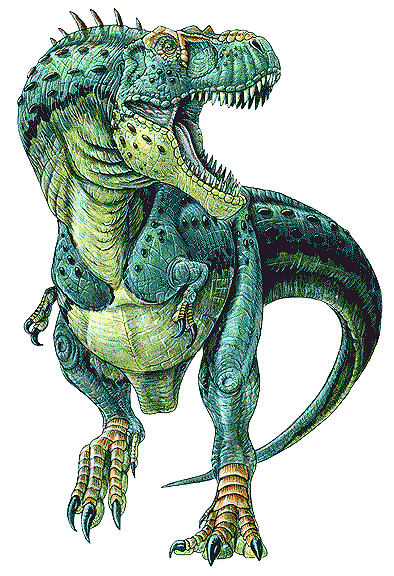|
|
 |
|
Tyrannosaurus rex
(Henry Osborn, 1912). |
|
 |
|
Name Means: |
"Tyrant Lizard" |
Length: |
40 feet (13 m) |
|
Pronounced: |
tie-Ran-o-Saw-rus |
Weight: |
6 tons (6,000 kilos) |
|
When it lived: |
Late Cretaceous - 67 MYA |
|
|
|
Where found: |
North America |
|
|
|
|
Introduction |
Tyrannosaurus rex ("king of the tyrannical
lizards"), also known colloquially as "The King of the Dinosaurs," was
a giant carnivorous theropod dinosaur from the Upper
Maastrichtian, the last stage of the Cretaceous period, 65 to 66
million years ago. The first discovered specimens played an
important role in the Bone Wars.
Tyrannosaurus Rex is widely regarded as the most famous dinosaur.
This is partly because it was the first very large carnivorous
dinosaur to be discovered and it was long believed to have been the
largest that ever lived. Another factor was that it was probably the fiercest meat eater that ever
lived. At more than 40 feet tall, it was huge and had the most
powerful head of any dinosaur. It also had the biggest teeth of any
dinosaur - teeth that were not only sharp and cutting edged, but also
thick and strong, capable of crushing bones. While there have been
sensationalistic claims of new, larger therapods "dethroning" T.
rex as the King of the Dinosaurs, evidence remains scant and open
to debate. T. rex will very likely remain a point of ongoing
scientific research and popular culture. |
|
Description |
| After many millions of years of evolution, T.
rex was an almost perfect killing machine. It was capable of running at
great speed to catch whatever it wanted to eat.
It had large feet to help it run quickly through the swampy
environment in which it lived, maybe as fast as 35 mph. Although it
had very short arms, they were very strong. But it didn't need its
arms to be an effective and efficient killer. It had enormous strength
in its jaws; it could bite right through the frill of a
Triceratops or into the back of a
hadrosaur. In fact, the only thing that a T. rex had to fear
was another T. rex. Most of the scars and wounds found on fossil bones
of these great creatures seem to come from others of its kind. |
|
Discovery |
The first specimen (a partial vertebra) was found by Edward Cope in
1892 and was described as Manospondylus gigas. Barnum
Brown, assistant curator of the American Museum of Natural History,
found the second T. rex skeleton in Wyoming in 1900. Brown
collected his second T. rex in 1902 and 1905 in
Montana. Barnum Brown eventually found five T. rex partial
skeletons. The dinosaur was assigned the name Tyrannosaurus rex
in 1912 by Henry Osborn.
T. rex is an excellent example of how our thinking about dinosaurs has
changed based on how much we have learned. Back in 1915 when the first
skeleton was mounted, most people thought it was a slow beast that
dragged its tail along the ground. This view was partially because it
would have been very expensive to mount it any other way, and
scientists weren't sure how it looked in life. Now, scientists are
confident that they understand how T. rex and other dinosaurs looked
and lived. T. rex probably walked and ran with its back and tail
parallel to the ground, its massive legs and hips a fulcrum for its
body. It was an active beast, and recent evidence strongly suggests it
was warm blooded. |
|
Fossils |
T. rex is very well known.
As of 2005 30 specimens had been found. Less than half of them
had significant amounts of fossil. Only three have complete
skulls. But still there is enough material to provide a very good picture of these
creatures.
the most complete Tyrannosaur rex fossil skeleton was discovered in
the Hell Creek Formation near Faith, South Dakota, on August 12, 1990
. It is 90% complete. It was eventually named "Sue," for
Susan Hendrickson, the amateur paleontologist who discovered it.
This fossil skeleton became the subject of a legal battle over its
ownership. In 1997, it was settled in favor of Maurice Williams, the
original land owner. The fossil collection was sold at auction
for $7.6 million by museum sponsors who gave it to the Field Museum of
Natural History in Chicago. . It has now been reassembled and is
currently on exhibit. Based on Sue's fossilized bones, she died at age
28 years, having reached her full size at age 19 years.
Researchers report that a sub-adult and a juvenile skeleton were found
in the same quarry as Sue; this lends evidence to the possibility that
T. rex ran in packs or other groups.
Another T. rex, nicknamed "Stan," in honor of amateur
paleontologist Stan Sacrison, was found in the Hell Creek Formation
near Buffalo, South Dakota, in the spring of 1987. After 30,000 hours
of digging and preparing, a 65% complete skeleton emerged. Stan
currently is on display in the Black Hills Museum of Natural History
Exhibit in Hill City, South Dakota, after an extensive world tour.
This tyrannosaur too was found to have many bone pathologies,
including broken and healed ribs, a broken (and healed) neck and a
spectacular hole in the back of its head, about the size of a T.
rex tooth. Both Stan and Sue were examined by Peter Larson. |
|
Species |
|
Three dinosaurs have been at various times been labeled as
tyrannosaurs. T. rex, the species type, was the first.
T. bataar is now recognized as being in a separate genus,
Tarbosaurus, and as has T. torosus which is now classified
as Daspletosaurus. Nonetheless, Daspletosaurus,
Tarbosaurus and Tyrannosaurus are very closely related, and
belong to the tribe Tyrannosaurini. |
| |
|
|
|
|
|
|
|
|
Edugraphics.Net | Feenixx Publishing |
|
|
|
|
|

